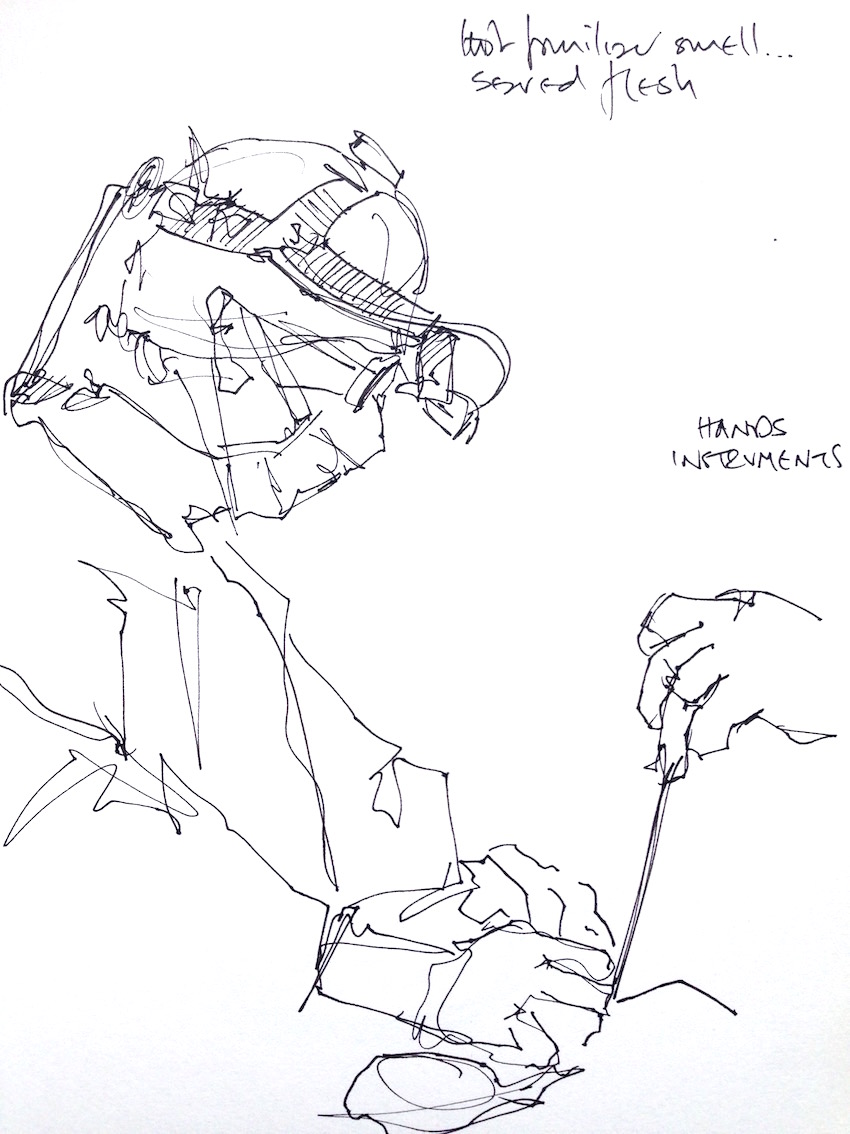This exhibition is the culmination of a decade of work and thought…
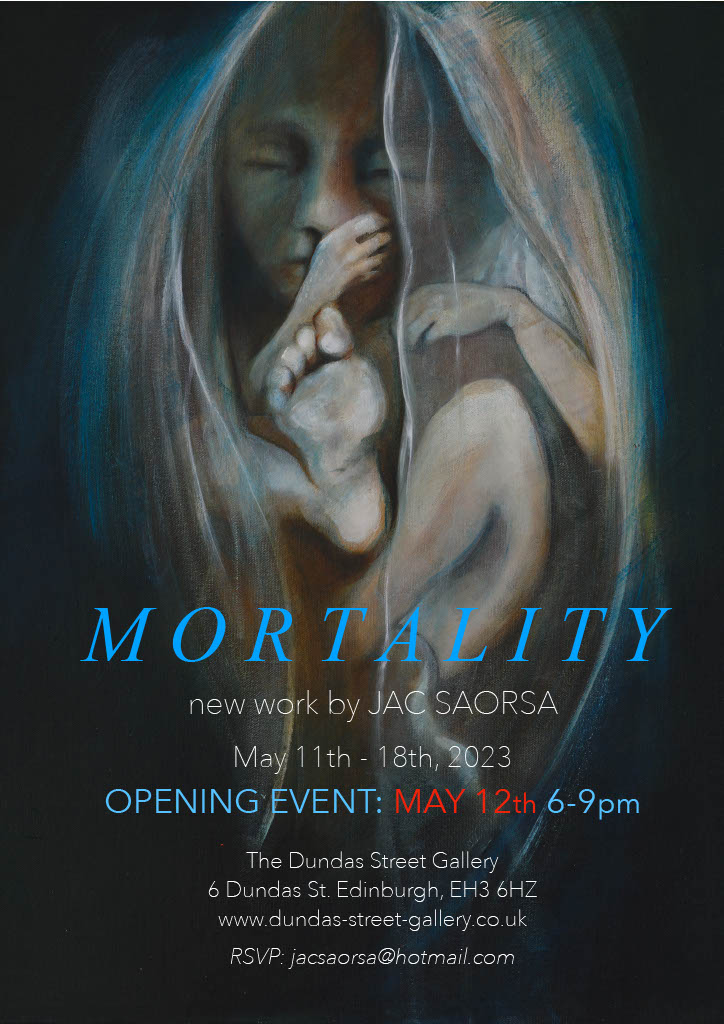

Travels with an artist
The self portrait is always a work in progress – a ‘becoming’ – a complex and continuous questioning of everything I think I know about myself. In drawing and painting it I do not recognise so much as ‘encounter’ myself, and as Deleuze says, to encounter is to find, to capture, even to steal, whereas to recognise is to regulate and to judge. Must I steal myself from myself? The movement of thought, of emotion as a movement of becoming – therein lies creativity.
Part of my absence from this page over the past few months was due to my working on my current PhD in creative writing at Cardiff University. I have been writing and painting in experimental and hybrid forms in the process of ‘Awakening Monsters‘. I have also been posting, as Artist-in- Residence, for SYNAPSIS a health humanities journal, which you can find here on wordpress:
https://wordpress.com/view/medicalhealthhumanities.com
It is an excellent journal that I am very proud to be associated with. Full of monthly contributions from a wide range of scholars with the medical humanities field there is always something thought provoking and intellectually relevant. The recent special edition focusing on COVID 19 is especially poignant and well worth a click on the above link find it.
I am also tweeting a lot of artwork at present. You can find me @JacSaorsa
via Like Any Other Woman now available!
It has been such a long time since I have updated this page but do please click on the link above to discover how you can read online/download Like Any Other Woman for absolutely no charge. And, if you prefer, you can buy the print edition on Amazon here:
Like Any Other Woman speaks to the suffering that cancer causes, and to the profound human experience of renegotiating the physical and emotional balance between sickness and health when that balance is tipped by the onset of disease. A profound and moving collaboration between an artist and a young woman who has endured the impact of a cancer diagnosis and its consequences, this is not a book about the cancer itself, the medical world of causes, symptoms, interventions and treatment regimes. It is rather about what it feels like when all sense of normality, all the expectations of a future that accompany good health, suddenly become submerged in degrees of suffering that impact both on the individual and on the people who care for and about her.
Even more good news is that I am busy recording in order to make Like Any Other Woman available as an audiobook! I will be less tardy in publicising that once it is available!
FANTASTIC NEWS FOR THE DRAWING WOMENS’ CANCER PROJECT! (check it out on the project site)
The book, Like Any Other Woman is to be published by Cardiff University Press: https://www.cardiffuniversitypress.org/ this autumn!
Written by myself in collaboration with Rebecca Phillips, the first woman to be involved with the project. Like Any Other Woman creatively and movingly documents Becky’s story, along with those of several other women who contributed to the project.
At twenty-four, four months before her wedding, she was diagnosed with vulval cancer, an ‘old ladies disease’. She wrote about her pain, her hopes, her fears, and her writing is too authentic not to be heard on its own terms. We agreed that I would write a book in which I would express through words (both hers and mine) and imagery, her experiences and the resonances with those of other women who have similar conditions.
Like Any Other Woman speaks to the suffering that cancer causes, to the profound human experience of re-negotiating the physical and emotional balance between sickness and health when that balance is tipped by the onset of disease. It is not a book about cancer itself, the etiological world of causes and symptoms. It is not about biomedical interventions that characterise individual treatment. It is about what it feels like when all sense of normality, all expectations of a future, suddenly become submerged in degrees of suffering that impact both on the individual, and on those who care for and about her.

All my life – my life that has become an extended paragraph – I seem to have been moving towards this one thing; losing myself in images that evoke words and words that evoke images. When I am cold I gather my pain around me like a thick, woollen cloak. It hangs heavily on my shoulders and the grey wool is stained and sodden with the pain of others. I cannot paint unless I write. I cannot write unless I paint. They feed off each other. They are ravenous. But they gnaw on me too. Is it possible to paint or write anything without anticipating another viewing or reading it? And if it is possible the question is why. Why do I paint/write? And what for? the pointlessness of the act tortures me, just as it sustains me.
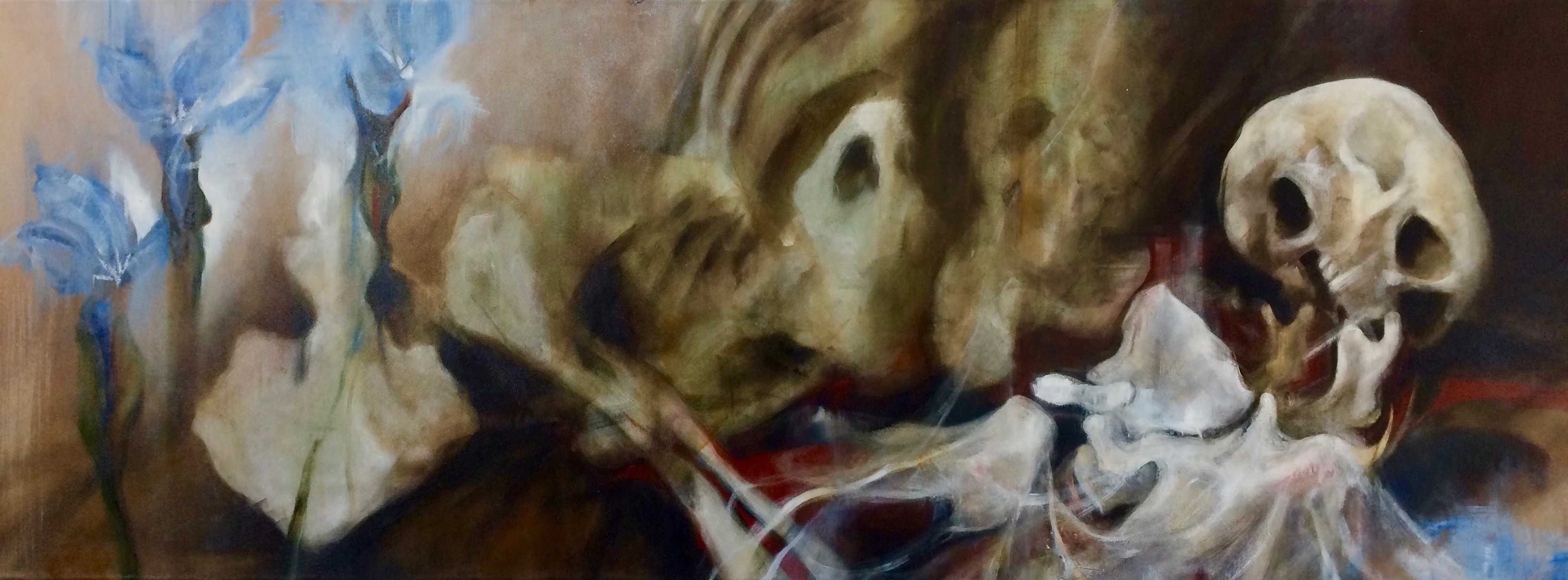
The agouti who lives beneath my my cabin is a beautiful creature. Think large guinea pig with long, thin legs. His coat of harsh fur is a beautiful brick red mixed with black and he moves quickly, gracefully between the buttress roots of the jungle trees. His tiny feet hardly make a splash as he trots through the clear water of the stream. I watch my agouti from the wooden deck of my cabin. I watch him brush through the lily pads that are beginning to bloom on the surface and they part, silently, with only the gentlest of ripples as he passes.
I am in Puerto Viejo once again. This is my annual pilgrimage to this small town on the Caribbean coast of Costa Rica. In Puerto Viejo I can breathe easy between the rainforest and the beach as my winter-bleached skin browns under the hot Caribbean sun. My cabin is in the rainforest. It is embraced and held in the humid comfort of green. All around me the cacophony of jungle sounds mingles with the crash of the waves on the shore, and this constant and natural orchestra wakes me in the morning, and lulls me to sleep at night. Once the harsh and suffocating reality of an eleven hour flight followed by a four hour taxi ride becomes merely something to forget, the sheer enormity of nature begins to seep into my consciousness. I become both less and more than I am; humble in the face of indescribable beauty, strangely confident in my ability to feel it. And I do feel it. The lifeblood of the jungle begins to move through my veins as if my pilgrimage has been to receive a transfusion.
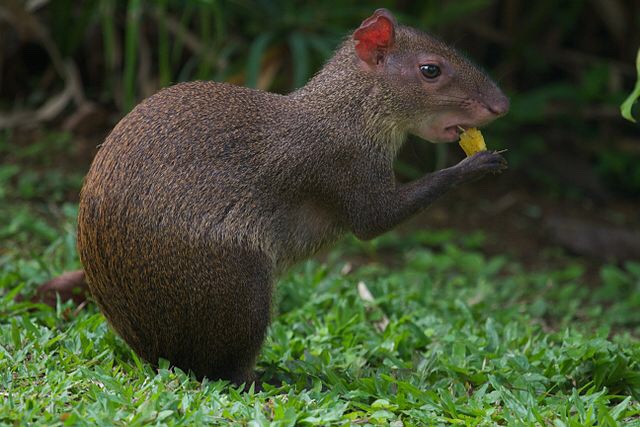
I must remain very still on the deck. My agouti is shy, timid, and he flees from me if I move. He is feeding, sitting upright on his haunches as he bites into hard seedpod that he clasps between his tiny front paws. Agoutis can bite through coconut shells and, along with macaws, they are one of the few species of bird or animal that can open Brazil nuts without the use of any tool. My agouti’s teeth are exceptionally sharp and strong. His eyes are bright and full of a wisdom that I, we, as humans cannot know.
I am writing, I am reading (Zona by Geoff Dyer, about Stalker by Tarkovsky, Bluets by Maggie Nelson, about blue, Death by Todd May, about mortality…and more…) and I am feeling. I am in Puerto Viejo.
I have been, and I am, writing, drawing and painting in a studio that is familiar, yet still alien to me. I have moved upstairs in the building. My old studio is now back to its original state as a teaching room, the heart of The Broadway Drawing School, and now, as every time I change the locus of my Being, the view from my window is over a strange new land. My studios over the years have been places where I inhabit and grow within, and I am at the same time excited and revolted by change. But I embrace it, as I would a dear, yet needy friend.
We have art in order not to die from the truth (Nietzsche, Notebooks 1888)
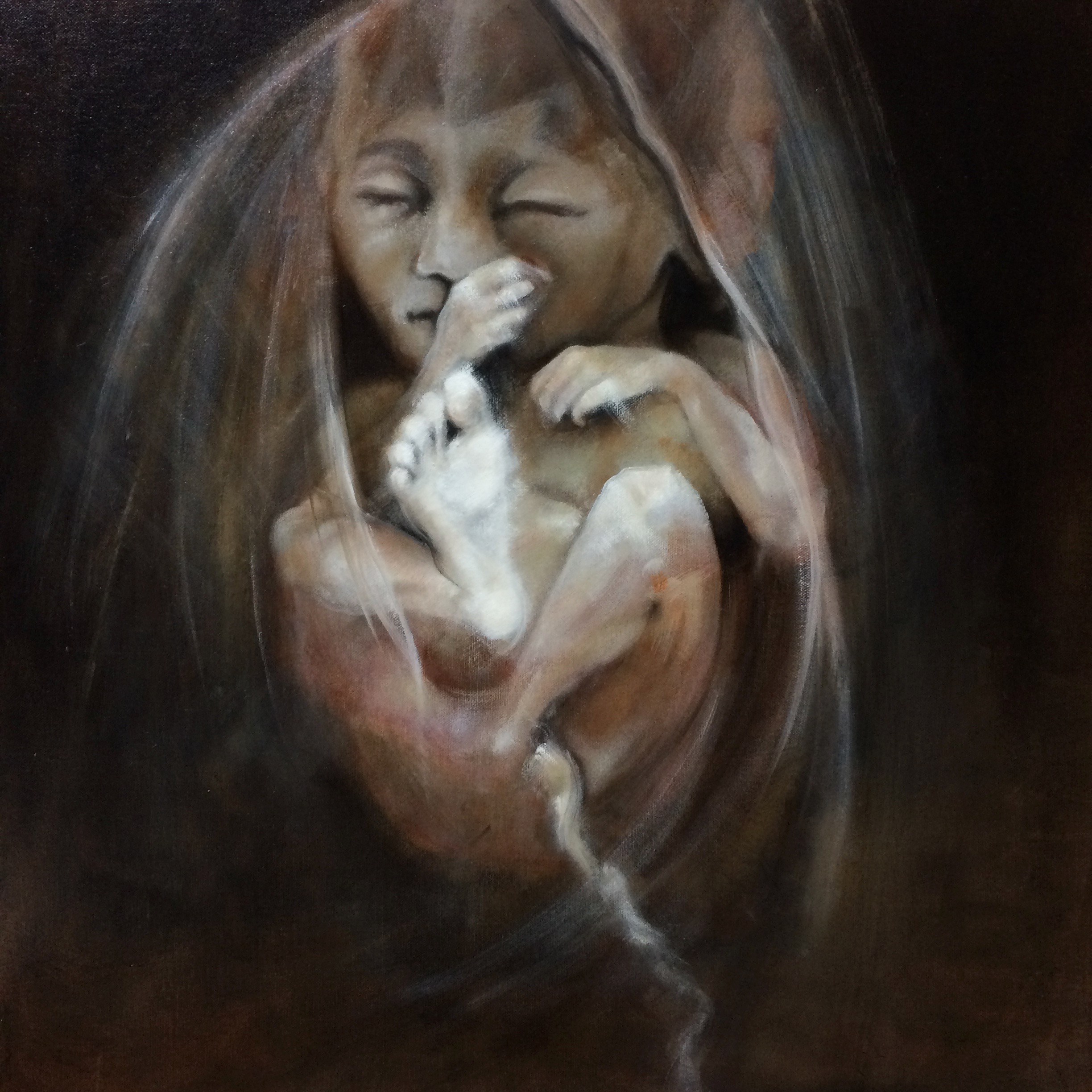
I am privileged to have permission from a friend and current Atelier student of mine to repost here his own recent blogpost. A gifted art educator in his own right, he eloquently expresses the ‘heart and soul’ of the practice of drawing from the live model, along with the regrettable ambivalence that pervades students’ access to such opportunities across our UK university system. The Broadway Drawing School in Cardiff is an independent art school where the heart beats strongly and the soul breathes, and where we consider such ambivalence an anathema.
The drawing is mine. The words are his.
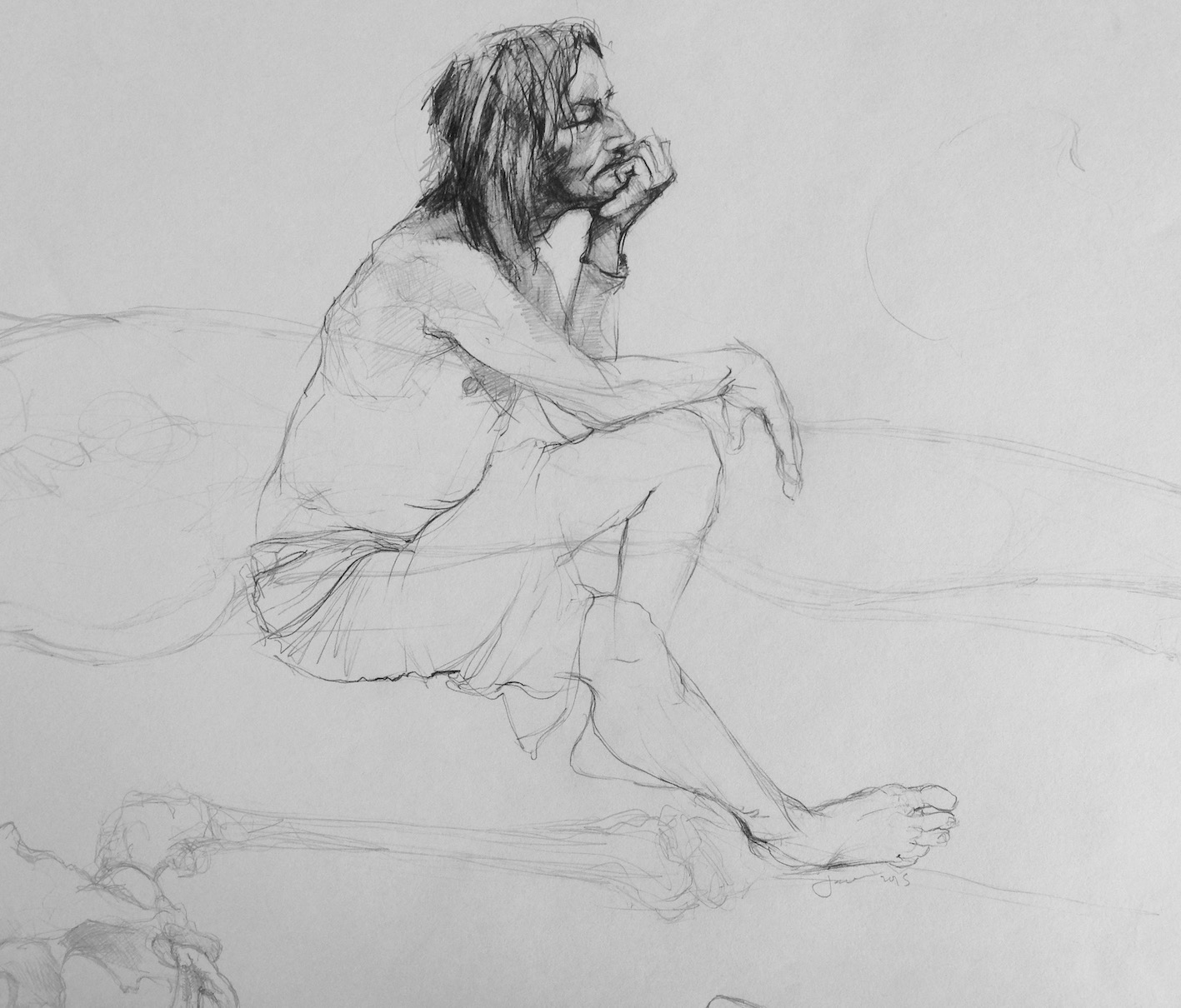
… ‘I’ve been life drawing since 1993, teaching it for 20 years, and been involved in decisions regarding accommodation for most of that time. It has allowed me a degree of perspective, time to question the practice, and also time to observe the personalities and cultures of the schools, faculties and institutions who’ve employed me in this capacity. For the outsider, it may appear to be an obscure, anachronistic, or opaque method for teaching in a world that is increasingly concerned with technological novelty, and with forms of education that are grounded in quantitative resolution.’
‘There have been periods in education where life drawing has fallen foul of fashion. The foundation course was born in the UK out of the Basic Design movement, which in turn drew heavily on the original Foundation course – the introductory year at the Bauhaus. Priority here was essentially non-figurative, addressing the essential qualities of colour, shape, form, texture and inherent materiality. Many UK art schools in the 60’s, gave life drawing a wide berth. If you look at the specification for the foundation course today, there is no mention of life drawing, although drawing from live experience, as an experimental process, covers the entire first semester. There isn’t a single art school of any quality, in the western world today, who would consider operating a foundation course, or any course of drawing, without life drawing. Life drawing, in observing the nude human form in space, can address every aspect of drawing. Line, tone, colour, texture, space, compositional design, description of form, division and arrangement of picture space, kinetics, spatial tensions and dynamics. There is a lifetime of study to understand the human form itself. Anatomy, balance, movement, weight, proprioception, stillness, the effects of time, gravity, and the relationship of each of these to historical and philosophical canon. Its relevance to human centred design practice, from fashion, animation or furniture design is unquestionable.
Quality here, is a key distinction. It underpins all questions related to teaching and delivery of life drawing, at every stage of the process. It is a distinction that many are happy to avoid, because teaching life drawing is often inconvenient in many ways. It requires time. Time out of a curriculum for which it is often seen as a supplementary practice. It requires time to learn. Its not an instant fix. The more you do it, the more you realise how much you have to learn. This means also that you need experienced staff. It requires space – a simple, large room, which is not a studio that is otherwise in daily use (meaning that all staff can access the room efficiently), in the same way that sportsmen access a gym. A suitable analogy. The room needs easels, furniture for the model, somewhere set aside for changing, adjustable heat, adjustable lighting, and a floor that can receive ink, paint or similar without hindering practice.
In his preface to Richer’s anatomy, Beverley Hale describes something close to the heart of life drawing as a learning process. He points out that when confronted with a model, the student draws upon an image of the figure which is held in the mind, as a means of dealing with what he perceives. The nature of the figure in the mind, dictates the success of the drawing. In simple terms there is a correlation between assumption of knowledge in the student and pitfalls fallen into within the drawing. Making a life drawing is a significant feat. The students enters a space and must confront the model, taking what they believe they know with them. They must then undergo an examination of perception, and on the surface of a blank page, translate the conversation between perception, knowledge, assumption and correction, through their own body, and the medium of their ability and familiarity with tools and materials. The evidence is present, visual, and unforgiving. Life drawing is a philosophical endeavour, as much as it is a practical one, asking the student to pass through an unsuccessful model of understanding, in the hope of briefly glimpsing a better one. This is true of every student in every life class, in every drawing, at every stage of development. Osi Rhys Osmond equated it to asking the student to become a better person. It is a microcosm of teaching and learning, based on a question that can never be answered. As such it is a process that must be considered continuous, and any desire to reduce the practice to the requirements of a module, has missed the point of it entirely. Pirsig discusses the first and second university – the first made of students and teachers, the second as a business/political model. There is obvious interdependence between both, but as a rapidly aging practitioner from the first, it’s my responsibility, sometimes, to communicate with the second…’
‘Economically, demographically, we’re in different circumstances to those we enjoyed in the mid 1990’s. The neoliberal project has put education under the yoke of private debt creation, driving higher level providers to drop all pretence of quality in pursuit of a rising bottom line. It’s a balloon that will burst in the next five years, as the ideological ravages of compulsory and further education, devastate choice in the pursuit of statistical accounting. When the second university remakes the first in its own image, the unanswerable question of the white sheet of paper in the life room, looks increasingly anomalous.’
‘As educators, we want to be better people. We want to face the unanswerable question, which is, ‘what do you know’ and also ‘prove it then’. There’s a danger… that there’s less space to ask the question…We need, in all things we do, quality rather than expediency. In a shrinking market… our only selling point is excellence. We have it. To preserve it, looking ahead, it might mean doing less, but doing it properly.’
‘I’m off now, to resume my own life drawing studies. Still hoping to be a better person.’
Here is the link to a Podcast for Anatomy education Podcasts. In this episode I talk about my project work in art and medicine and in anatomy. You can listen at http://anatomypodcast.co.uk/episodes/dr-jac-saorsa/
